CUISINE NISSARDE LABEL
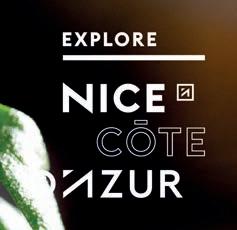
Press kit 2023/24
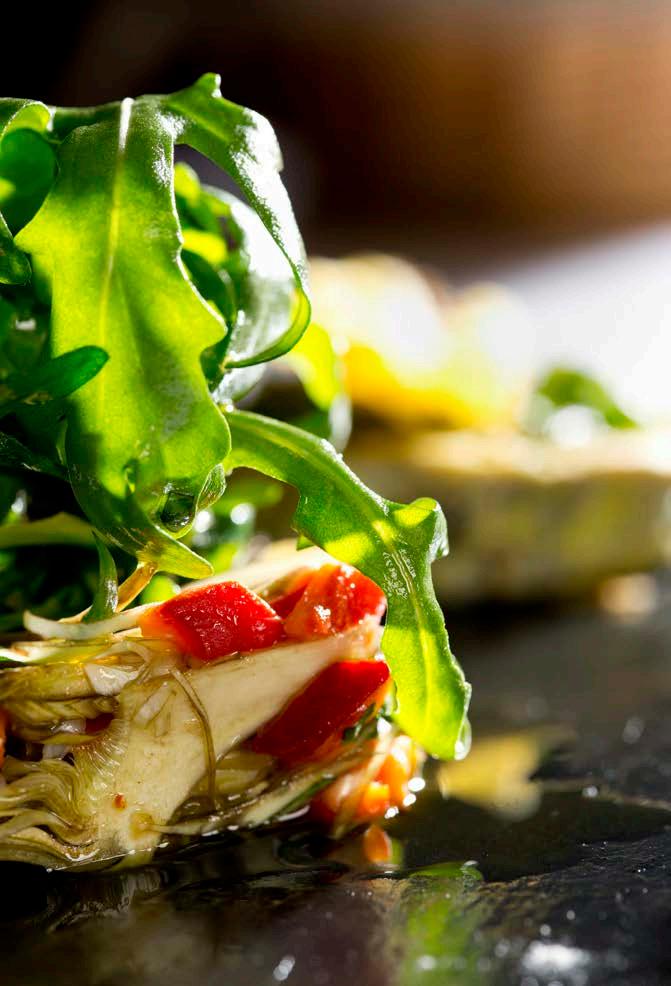


2 2023 - Press kit - Cuisine Nissarde Label Press Department Isabelle Billey-Quéré Tel. +33 (0) 4 92 14 46 15 Tel. +33 (0) 4 92 14 46 10 presse@nicecotedazurtourisme.com Contact label for professionals Marie-Laure Fiammengo +33 (0) 4 92 14 46 16 marie-laure.fiammengo@nicecotedazurtourisme.com 3 Key figures 6 Nice, the cuisine and its label in heritage 7 Label « Cuisine nissarde » 8 Auround the label Cuisine Nissarde 9 A history of Nice’s cuisine 13 Protected Designation of Origin 14 Certified restaurants 16 County of Nice cookery books 17 Some recipes contents
KEY FIGURES

NICE CITY
2nd
LARGEST AIRPORT AFTER PARIS
LARGEST CRUISE PORT AFTER MARSEILLE

10 KM OF COASTLINE With 7.5km of beaches
2nd
5th
LARGEST CITY IN FRANCE
LARGEST CONVENTION HUB IN FRANCE AFTER PARIS
97% OF VISITORS SATISFIED WITH THEIR STAY

5
MILLION
VISITORS PER YEAR
A STRONG CONCENTRATION OF MUSEUMS LABELLED «MUSÉE DE FRANCE»
2nd
INTERNATIONAL TOURISM DESTINATION IN FRANCE

300 HECTARES OF GREEN SPACE
DAYS OF SUN PER YEAR

1rst
FRENCH CITY TO HAVE BEEN GRANTED A WINE-PRODUCING AOP




ONE OF FRANCE’S LEADING NETWORKS

OF HOTELS FACILITIES both in terms of quality and capacity




NICE COTE D’AZUR METROPOLIS
80%
MADE UP OF MOUNTAINOUS TERRAIN

51 MUNICIPALITIES
550 500 INHABITANTS
3 2023 - Press kit - Cuisine Nissarde Label
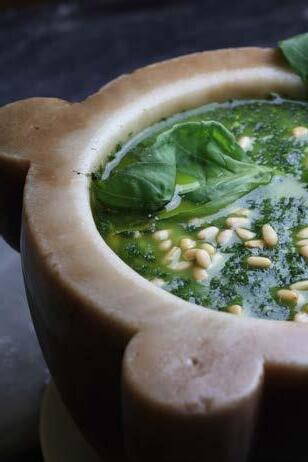
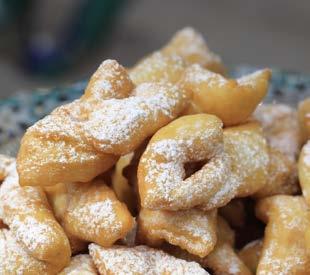



4 2023 - Press kit - Cuisine Nissarde Label
NICE, the cuisine and its label in heritage
Nice, 5th city of France and 2nd international tourism destination, is a modern and active capital that managed to preserve its lifestyle during the centuries of a rich and intense history, drawing its energy between sea and mountains: its cuisine is a reflection of this situation.
The «Niçoise» cuisine has the name of its city in its appellation: «Cuisine Nissarde, le respect de la tradition». This appellation was created in 1998 by the UDOTSI (Departmental Federation of the Offices of Tourism) and the local traditional association the Capelina d’or. The objective was simple, and remains, to reassert the value of the authentic Nice cuisine while preserving the memory of its past.
Since 2014, the label is managed by the Nice Côte d’Azur Convention & Visitors Bureau which wished to give it news impetus. The spirit has been preserved in order to guarantee its durability. To this end, a Technical Committee, rules and an evaluation grid were created.
On this first edition, 17 restaurants received the label at an official ceremony.
This year, 33 restaurants and take away have been awarded in two different categories ( the Niçois specialties and « Merenda e Goustaroun »), for one year. A certificate and a plate were given on 3rd July 2023.
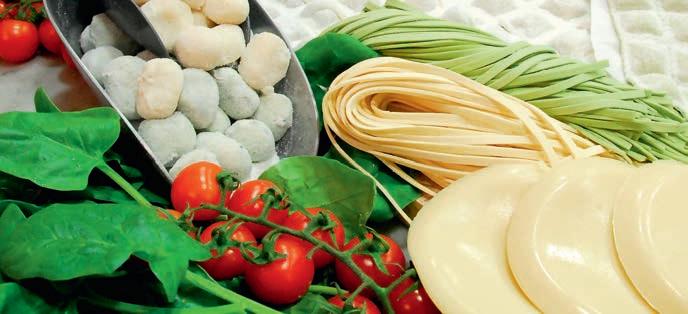
A quality approach
The Nice Côte d’Azur Convention & Visitors Bureau (OTM) has strengthened its certification procedures to ensure that a high level of excellence is maintained in all areas, always with the aim of offering greater quality, service and pleasure... Thanks to this dynamic, you can enjoy great experiences in Nice with complete confidence.
NAMELY :
The ‘Niçoise’ cuisine reflects the respect for the regional products and lifestyle, always accompanied by the famous olive oil –with an AOP, Registered Designation of Origin- and aromatic plants. The restaurants, which have received the «Cuisine Nissarde» label, are easy-to-identify by the plate on their window. Lifestyle, sensuality and authenticity are the first emotional qualities, given spontaneously to Nice. All forms of pleasure are joined together: gastronomy, culture, shopping, and nightlife…
5 2023 - Press kit - Cuisine Nissarde Label
LABEL « CUISINE NISSARDE » a quality approach
In 2015, the Nice Convention and Visitors Bureau reinforce its approach of labeling, in order to, in all areas, to observe a level of excellence… always keeping in perspective: more quality, service and pleasure… Thanks to this dynamism, it is possible to have large experiences in Nice, with complete trust. The «Cuisine Nissarde, le respect de la tradition» label
In order to develop its actions in favour of a targeted tourism offer of quality, the Nice Convention and Visitors Bureau has relaunched the «Cuisine Nissarde» label to put forward restaurants which:
- respect traditional recipes,
- are attached to the heritage and the history of Nice cuisine,

- propose a cuisine and a welcome of quality.
The aim is to save, promote and perpetuate Nice cuisine, which is a world-renowned.
Restaurants, which hold the brand «Cuisine Nissarde», are committed to cook the typical dishes from Nice (a minimum of from three recipes for the Merenda category and five for the restaurants); defined by this committee with the respect of the established recipes. They also have to take into account the quality of the products, have a knowledge of the history and the heritage of Nice, take care of the quality of their welcome and information, respect the regulations in terms of hygiene and security and are easy-to-identify by a «Cuisine Nissarde» label plate on their window.
In order to choose some typical dishes from Nice, the Nice Convention and Visitors Bureau have been surrounded by professionals and experts of the Nice cuisine around a Technical Committee. Finally, 44 recipes have been selected in commission.
«Mystery» customers visit these restaurants to check that the criteria for awarding the label are being met after the fact. Establishments wishing to join can apply at any time to the OTM. Although the initiative was launched in Nice, it is not limited to the city itself, and applicants from all over the region are welcome to apply.
The range «Merenda & Goustaroun» (snack) has been created in 2017. It perfectly reflets the local eating habit outdoors. The picnic is, here, almost an art and many recipes of the «Cuisine Nissarde» are fully adapted to this tradition.
To date, the Committee has 13 members, all of whom love and fervently defend the label. Chefs, cookery teachers, producers, gastronomes and historians are its guarantors. This dynamic has brought people together and created a momentum that is now reflected in initiatives around the label.
6 2023 - Press kit - Cuisine Nissarde Label
AROUND THE LABEL CUISINE NISSARDE
INITIATIVES TO PERPETUATE NICE’S HERITAGE
A culinary heritage to promote
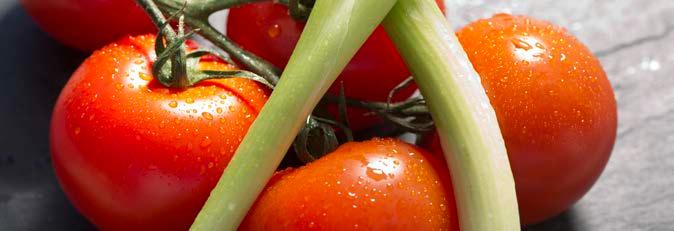
With a view to preserving the traditions of Nice’s cuisine and making them part of a shared heritage, an application has been submitted to UNESCO for inclusion in the World Heritage List of Intangible Cultural Heritage. The French Ministry of Culture has approved the application. From 2019, Nice cuisine will be part of France’s intangible cultural heritage.

Dedicated professional training
With the aim of safeguarding and promoting the traditional heritage of Nice cuisine, the Apprentice Training Centre, attached to the Lycée Hôtelier Paul Augier in Nice, gives pride of place to Nice cuisine and its products.
This knowledge is passed on in partnership with restaurateurs with the «Cuisine Nissarde» label, cookery and history teachers and local producers. The CFA has chosen to reinforce this teaching, which is already part of the curriculum, with more practical classes.
In its decision, it notes that «linked to the sea as much as to the mountains, Nice cuisine is one of the few in France to offer a complete meal, from starters to desserts, in any season...». Its unique character is also due to the political and geographical isolation of the Comté de Nice for several centuries. This self-sufficiency gave rise to inventiveness that was complemented by contributions from outside. A cuisine of simple origins, of social conviviality and integration, of respect for fresh, regional produce, it is totally integrated into the strong identity of Nice on a stable and ancient base. This classification is a wonderful tool. It helps to raise awareness of the importance of cuisine to the culture and heritage of Nice. Everything possible is being done to promote it. This involves safeguarding, developing and passing on the heritage as an element of identity in the same way as history or language.
For this 2023/2024 edition, a label of honour has once again been awarded to the Lycée Hôtelier Paul Augier de Nice, in recognition of the commitment of the management team and the teaching staff to promote the cuisine of Nice in the training programmes.
To this end, the school has undertaken to offer a seasonal Nice menu once a week in one of its 3 restaurants - Les Galets, la Prom and la Rotonde.
www.cfaregionalhotelierdenice.com
Life style
Nice Côte d’Azur is a land of gastronomy with 12 Michelin starred restaurants. A reflection of local knowhow and quality.
7 2023 - Press kit - Cuisine Nissarde Label
ATELIER DE CUISINE NIÇOISE
An introduction to cuisine niçoise
Located in the heart of the Old Town, near the Cours Saleya and its market, on the ground floor of the Palais du Sénat, a historic site that is already home to the Nice heritage centre, the “Atelier Cuisine Niçoise” offers cooking classes, culinary competitions, exhibitions and product presentations.
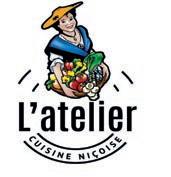
This year, the Nice Côte d’Azur Metropolitan Convention & Visitors Bureau took over management of the «Atelier de cuisine niçoise». Originally, the City of Nice wanted to promote this cuisine by offering a place where traditional culinary skills could be passed on and learnt. L’Atelier offers courses, in the heart of Vieux Nice, close to the Cours Saleya market, in the former Senate building which also houses the Heritage Centre.
L’Atelier has a classroom – accessible to people with reduced mobility – with 12 workstations and all the equipment necessary for the many recipes developed throughout the seasons. Depending on the chosen course, participants can learn the emblematic recipes of Nice’s cuisine before tasting them on the spot or taking their creations away to enjoy with their loved ones. Pissaladière, stuffed vegetables, gnocchi, “capouns” and other savoury or sweet chard pies will no longer hold any secrets for them.
As a family, as a couple, with friends or simply to treat yourself, it is possible to discover the richness of Nice’s culinary heritage by “getting your hands dirty” in the company of a chef specialised in Nice cuisine.
https://www.explorenicecotedazur.com/en/ atelier-cuisine-nicoise/

8 2023 - Press kit - Cuisine Nissarde Label
A HISTORY OF NICE’S CUISINE
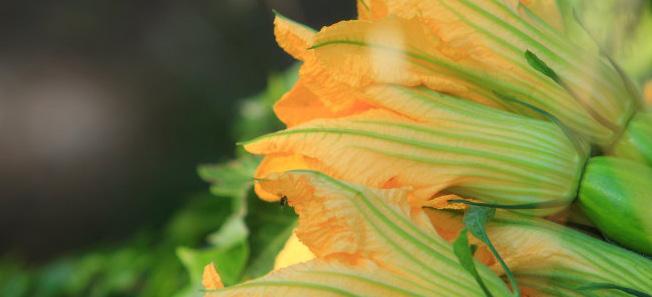
the land
The Nice region is a land of age-old culture and history that has learnt over the centuries to use external influences to its advantage while building on its traditions. It’s the development of trade routes from the 18th century onwards was the biggest contributing factor in spreading awareness of Mediterranean food and Nice’s cuisine.
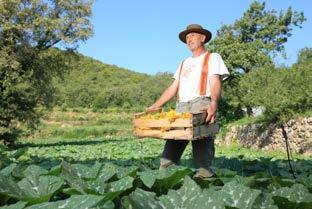
The earliest forms of barley cultivation appeared in our region 3 000 years ago. Although the Greeks developed grape growing in the 6th century BC, the Romans were the first to truly shape farming land on which to grow olive trees, vines and wheat. For a long time, a culture of subsistence agriculture with poor harvests dominated, as the natural environment was harsh: the soil was poor, water was scarce and the craggy landscape called for ‘faissas’ to be built - little sloped terraces that had to be cleared and held up by dry stone walls.
Wheat was used to make bread and pasta. Vegetables such as beans, peas, lentils, broad beans, chard, aubergines, leeks, onions, marrow, cabbage, cardoon, radishes and carrots, among others, were grown in family vegetable patches. Brought back from the Americas in the 16th century, tomatoes, peppers, potatoes and corn were only grown in the County of Nice beginning in the 17th and 18th centuries. Harvesting and gathering supplemented these foods, bringing herbs and mushrooms with which to flavour and garnish dishes, while the wide variety of wild salad
leaves and greens gave us what we now call «mesclun». Local fruits such as figs, grapes, chestnuts, walnuts, hazelnuts, pears and apples provided sugar. Almonds, apricots, peaches, prunes, melons and watermelons were introduced to the region by the Greeks and Romans. Originally from Asia, citrus fruits were successfully grown in our region beginning in the 16th century as were persimmon and medlar fruits much later.
9 2023 - Press kit - Cuisine Nissarde Label
A HISTORY OF NICE’S CUISINE the climate
Although the climate in the Nice area and the Côte d’Azur has done much to boost tourism development in the region, for a long time it was a significant obstacle to local farming life.
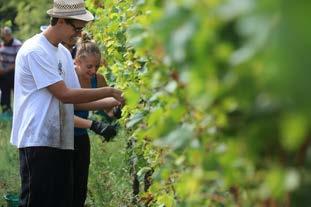
Indeed, long periods of drought broken up by violent, sometimes devastating storms, threatened good harvests and pastoral activity. Communities were consequently forced to adapt farming to the climate, which explains why plant species requiring little water such as olive and fig trees, vines, almond trees, etc. were introduced. The olive tree has been grown since Antiquity and became the ultimate symbol of Mediterranean culture for a multitude of reasons.
For a long time, olive oil was the only grease used in cooking, seasoning and preserving food. Olives are also eaten at the dinner table or turned into tapenade, a condiment that was already known to
and loved by the Romans. Olive oil boasts a number of dietary virtues that combine to make it a muchdesired product today.
The cultivation of vines was an integral part of the agricultural landscape for a long time, before being concentrated into fine wine production. This lead to the «Vins de Bellet» appellation, drawing its name from the hills upon which the vineyards unfurl. Wines from Villars-sur-Var and Baous are also very well-known and much-appreciated.
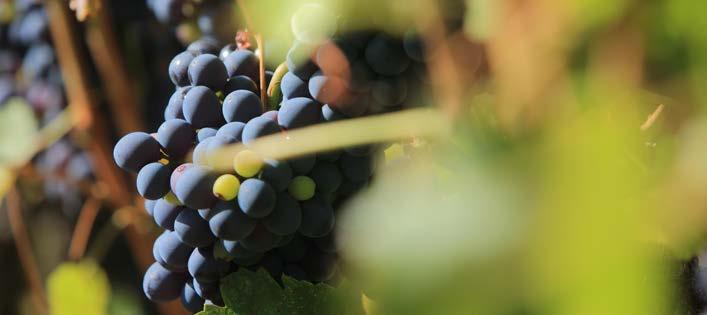
GLOSSARY
Mesclun : mixing
Pan Bagnat : wet bread
Bagna Cauda : warm bath
Bigneta : fritters
Raiola : raviolis
10 2023 - Press kit - Cuisine Nissarde Label
A HISTORY OF NICE’S CUISINE
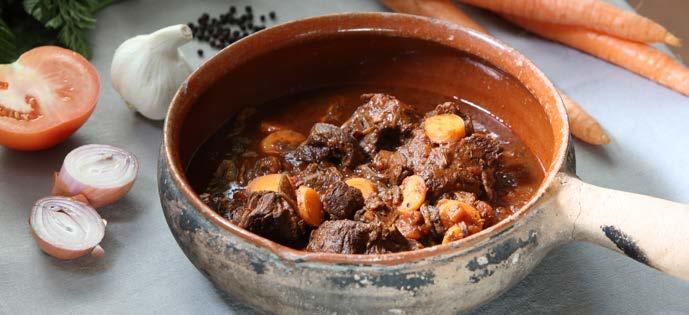
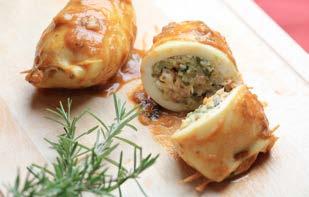

the coast
Tucked between sea and mountain, the inhabitants of the Nice region were also forced to adapt their pastoral activities to the hilly surroundings and difficult climate by choosing to raise goats and sheeps which survive on little grass and live on craggy land. Locals have always eaten little meat, as it was a rarity and thus too expensive.
Traditionally at times of celebration, sheep or kid was served for Easter, offal was prepared as were local tripe specialities, ‘trule’ blood pudding, caillettes from the valleys or cheaper cuts of meat such as veal breast or stewing meat. Hens were mainly reared for eggs, while rabbit and sometimes pork provided the occasional treat. Hunting and fishing allowed locals to add some much-appreciated variety to their diets.
Down by the coast, the sea is sadly lacking in fish. Locals mainly eat sardines, anchovies, some types of rock fish, octopus and crustaceans (sea urchins, crabs) fished locally, as well as salted (cod) or dried (stockfish) fish, brought back from the ocean thanks to maritime exchange. «Poutine» sardines and sandsmelt in their larval state and «Nonnat» gobies are highly sought-after and original local specialities. Authorised from January to March by derogation, this fishing ought to have been forbidden from 1 January 1997 by a European provision, but local fishermen applied for a 30-year derogation to this act.
11 2023 - Press kit - Cuisine Nissarde Label
A HISTORY OF NICE’S CUISINE
the traditions
Nice’s cuisine follows the natural cycle of the seasons and festivities. Meals are determined according to the family harvest: in summer, the main dish includes a tomato salad with sauce and bread, vegetable stuffing, ratatouille and omelettes, while in the winter cabbage, leek, pulses, soups, baked sliced marrow and fish or meat stews take centre stage.
Sunday dinner is a more elaborate affair. It usually includes a starter (tomato salad in the summer or onion, anchovy and olive pizza) followed by a main dish of pasta, gnocchi or ravioli, designed to fill guests up. On special occasions, a meat dish with sauce would generally follow. Dishes are eaten one at a time. Cheese is rarely served. Meals end with fresh fruit in the summer and dried fruit in winter.
Sweets are prepared for some special occasions: sweet chard pie and ganse doughnut pastries are made for Carnival and the 13 traditional desserts are served at Christmas… During the week, housewives draw on their creativity, using leftovers and what they
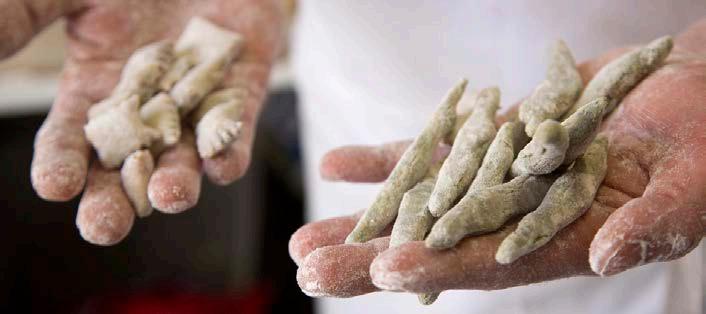
have to hand. Leftover meat from Sunday dinner can be turned into stuffing that is used in many of the different dishes that have become special delicacies unique to Nice’s cuisine: vegetable stuffing, stuffed veal breast, ravioli, etc.
Known as a ‘merenda’, a typical snack in Nice involves drenching round crusty bread in olive oil garnished with the ingredients of a Niçois salad, the succulent ‘pan bagnat’ or ‘socca’, a thin chickpea flour pancake cooked on a large tray and cut up into little portions.
PRODUCTS MADE FROM «OLIVE DE NICE» IN LOCAL GASTROMONY
The «Nice olive oil», natural product, can be used hot or cold. It is used in many local dishes : the «Pan Bagnat», socca , pissaladière , ratatouille , the bagna cauda ...
The «olive de Nice» is the perfect olive for Mediterranean appetizers and brighten up many specialties of Nice .
The «Paste Olive de Nice» is simply eaten a piece of bread as an aperitif or with raw vegetables. It go well with fis or pasta.
12 2023 - Press kit - Cuisine Nissarde Label
NICE, Olive and olive oil
the Protected Designation of Origin
For a long time, olive growing and trade was one of Nice’s major economic sectors. Its decline was ushered in by the two world wars that drained the region of its workforce and changed both production costs and diets.

Table olives are steeped in sea salt brine. After six months of salting, their flesh is subtle, slightly crunchy under the tooth, with an unparalleled fruity flavour.
Nice’s AOP olive oil is made from olives harvested from the hillsides between November and April. Harvesting is traditionally carried out by hand-pole beating.
The Alziari oil mill is the only one of its kind in operation in Nice and offers visitors the chance to discover how oil is made for themselves.
Vin de Bellet
The Bellet vineyard is undoubtedly one of the oldest in France and its plantation seems to date back to when the Phoenicians founded Marseille. Having been granted its AOC in 1941, today Bellet wine is known around the world and can be found at the most prestigious of tables Regions. The AOC covers approximately 650 ha of which 65 ha are in use.
The hillsides are located on the final foothills of the Alps, at an altitude of between approximately 200 and
300 metres, all within the territory of the commune de Nice municipality. The vineyard enjoys full sunlight (approximately 2 700 hours per year), nourishing rainfall (838 mm per year) and a unique micro-climate due to its altitude and winds (the Mistral and Tramontane) that sweep almost continuously across the valley.
This climate allows for a slow maturing process that is crucial to the crisp refinement of white and rosé wines.
The vines take root in narrow beds of rounded pebbles known as ‘restanques’, which are mixed with a very light-coloured sand (poudingue) along with a little clay. Together, these excellent conditions draw out the character and full maturity of the grapes to create smooth red wines. The main grape varieties are Rolle, Chardonnay, Folle noire, Braquet, and Grenache.
FUN FACT
- The renowned caillette (the name given to olives from Nice) is noted for its quality and delicacy in the Encyclopaedia of Diderot and d’Alembert.
- The oil mill of Alziari, the only in operation in Nice, propose to discover oil production.
13 2023 - Press kit - Cuisine Nissarde Label
CERTIFIED RESTAURANTS
After the call for applications by local restaurants for the ‘Cuisine Nissarde’ label, members of the Technical Committee have assessed applicants and have met to validate selection criteria. This year, we pay a special tribute to the André Giordan promotion in honour of the recently deceased member of the Technical Committee. The restaurants to be approved are the following:
In Nice…
Acchiardo
38 rue Droite, 06300 04 93 85 51 16
A Buteghinn’a*
11 rue du Marché, 06000 04 93 92 28 22 abuteghinna.fr
Auberge de l’aire St Michel
Chemin de Chateaurenard, 06100
04 93 84 49 88/09 83 34 15 03
Lou Balico
20 av. Saint-Jean-Baptiste, 06000 04 93 85 93 71 loubalico.com
Chez Cane
317 avenue de Fabron, 06200 04 93 8678 03
chezcane.com
L’Escalinada*
22 rue Pairolière, 06300 04 93 62 11 71 escalinada.com
Lu Fran Calin
5 rue Francis Gallo, 06300 04 93 80 81 81 lufrancalin.com
La Gaité Nallino
72 avenue Cap-de-Croix, 06100 04 93 81 91 86
lagalitenallino.com
Le Pois Chiche
Novotel Nice Centre Vieux Nice
8/10 parvis de l’Europe, 06300 04 93 13 30 93 www.novotelnice.com/restaurant
La Ratapignata*
63 avenue du Ray, 06100 04 92 15 06 39
+33 (0)4 83 50 33 24
Le Safari
1 Cours Saleya, 06300 04 93 80 18 44 restaurantsafari.fr
La Table «à» Julie 50 rue Arson, 06300 04 92 04 43 50
latableajulie.eatbu.com
La Table Alziari
4 rue François Zanin, 06300 04 93 80 34 03
Le Tchitchou
29 Avenue Georges Clemenceau 06100 Nice
09 83 34 15 03
Cuisine nissarde créative
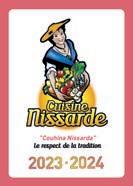
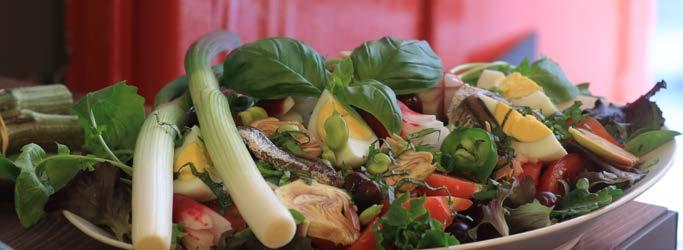
Chez Davia
11 bis rue Grimaldi, 06100 09 83 34 15 03
chezdavia.com
14 2023 - Press kit - Cuisine Nissarde Label
Around Nice…
Lou Bantry
13 quai de l’Amiral Courbet
06230 Villefranche sur Mer 04 93 91 87 68 restaurant-lou-bantry.fr/
La Capeline
D17 hameau le Vescous
06830 Toudon
04 28 31 71 73 restaurant-lacapeline.fr
In Nice…
A Buteghinn’a
11 rue du Marché, 06000 Nice
04 93 92 28 22 abuteghinna.fr
D’Aqui
28 rue Cassini, 06300 Nice
07 66 77 69 23
Barba Bléa *
23 rue Delille, 06000
04 97 08 04 81 barba-blea.com
Chez Thérésa
28 rue Droite & Cours Saleya
06300 Nice
04 93 85 00 04
Lou Countea
7 Boulevard du Dr Morani
06830 Gilette
04 93 73 97 50 restaurant-loucountea.com
L’Estragon
101 route de Nice
06510 Le Broc 04 93 29 08 91
La Gaudriole
4 rue centrale
06610 La Gaude 04 93 24 88 88
La Passion des Mets
14 Boulevard Louis Roux
06700 Saint-Laurent-du-Var
04 93 89 46 17
Le Pous Café*
4 place du Champas
06420 Rimplas 04 93 02 87 70 le-pous-cafe.eatbu.com/
La Table du Rousset
Montée de la Bourgade
06260 Ascros
06 60 36 05 38 reservation required
MERENDA E GOUSTAROUN
The approved street food
The range has been created in 2017. It perfectly reflects the local eating habit outdoors.
The picnic is, here, almost an art and many recipes of the «Cuisine Nissarde» are fully adapted to this tradition.
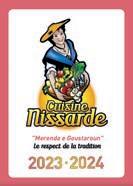
Lou Pelandroun °
4 boulevard Joseph Garnier, 06100
04 93 98 47 06
Receta de Jou
4 place de la Gare du Sud, 06100 Nice
09 86 25 35 03
Socca du Cours °
Chez Marie Thé
6 rue Place vieille, 06300 Nice
06 80 28 18 77
Around Nice…
La Boulangerie du Terroir*
Chez Alec & Bruno
Saint Dalmas
06420 Valdeblore
06 60 05 09 40
Les Halles du Mercantour ° 50 rue Docteur Cagnoli, 06450 Saint Martin Vésubie 04 93 03 20 32 hallesdumercantour.fr
La Passion des Mets 29 avenue des Filagnes 06700 Saint-Laurent-du-Var 04 93 14 34 91
La Raïola du Béal Maison Galarato 1 avenue Cyrille Besset 06800 Cagnes-sur-Mer 04 93 73 72 50
*newrestaurantonthelist 2023/24
15 2023 - Press kit - Cuisine Nissarde Label
COUNTY OF NICE COOKERY BOOKS


Cuisine of a poor country, the cooking of the County of Nice uses seasonal and local ingredients. The vegetable is king and waste is prohibited. It is the very precondition for a healthy diet. Local growers, low food miles, flexitarian (before the word had been conceived), it consisted, as previously mentioned, of a lot of vegetables, a little meat and fish, olive oil and herbs.
The Nice Convention and Visitors Bureau has supported the Nice Cuisine label since its beginning and bears it forward today in its achievement and development.
Respect and handing on the heritage are the very essence of the existence of the label. Preserving this culture, ensuring that it endures, offering it a quality setting, these are what motivates the Nice CVB in this endeavour.
«This work, which, have no doubt, will become a referenceforourcuisineandouridentity.»
Jean-MarcGiaume,ChairoftheCaisseLocaleoftheCréditAgricole deNice.
The conclusion of this work is part of this quality approach. Taken forward by the label and the Technical Committee which re-evaluated all the recipes, the «County of Nice Cookery Books» have a legitimate claim to be the reference of the «Cuisine Nissarde» label and furthermore, the memory of this ancestral art which lives and reflects the soul of this region. They also extend formal support to the candidacy of Nice cooking to the World Intangible Heritage for Humanity.
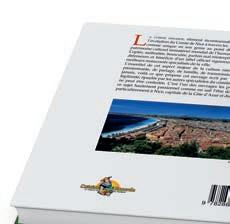
The Authors
Alex Benvenuto
History and cooking enthusiast since an early age, a specialist in Nice and its County, Alex Benvenuto is naturally a member of the Technical Committee for the «Cuisine Nissarde» label. His authority in drafting this booklet is therefore total and almost obvious.

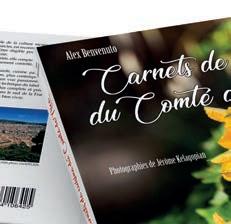
Jérôme Kélagopian
Photographer and artist, Jérôme Kélagopian has been working with the Nice Convention and Visitors Bureau for many years to enhance Nice as a destination and its attractiveness. His eye and art (mastery) could only aggrandise the recipes of «Cuisine Nissarde.» Published
For sale: Online shop, nicetourism.com, the reception offices of the Nice Convention and Visitors Bureau and bookshops.
16 2023 - Press kit - Cuisine Nissarde Label
SERRE EDITEUR
€
by
192 pages -
29
Some recipes
F
La Salade Niçoise

La Salada Nissarda
SaladeNiçoiseispartofthemythologyofNice.Wecleavetothisemblem...,eventhoughithasevolvedover time.Eachneighbourhood,everyvillage,everyfamilyhaditsownversion.SaladeNiçoisebelongsessentiallytothe oraltraditionandisnottobefoundinoldrecipebooks.Thisdoesnotmeanthattherearenorules…
Ingredients for 8 people
> 100 g mesclun,
> 500 g tomatoes,
> 100 g spring onion,
> 100 g small white celery hearts,
> 400 g small purple artichoke,
> 160 g small green salad peppers,
> 250 g long “18 day” radishes,
> 50 g black Nice olives,
>400 g broad beans (in season)
> 200 g tuna in olive oil,
> 8 salted anchovies (i.e. 16 fillets),
> 20 g garlic,
> 100 ml olive oil,
> 4 eggs,
> 8 to 12 basil leaves (to taste),
> Fine salt & ground pepper.
Preparation time: 20 minutes
Cooking time: 8 minutes (cooking the eggs)
Season: spring - summer
Variations
> red wine vinegar
> 200 g cucumber
Wash the vegetables. Clean the radishes, keeping them whole with the tender leaves. Garnish a broad dish, previously rubbed with garlic (using a peeled clove), with mesclun (mixed salad leaves). Cut the tomatoes into quarters and place them on the leaves of mesclun, salt. Finely chop the white of celery and the soft part (heart) of artichokes, green peppers and spring onions (syboes). Add small broad beans (in season). It is presented flat, by arranging the vegetables on the tomatoes and taking care of the look of the dish. Add salt. There should be no problem about serving because it is not a salad that is mixed before serving. Add the tuna leaving fairly large pieces, the snipped basil and decorate with hard eggs cut into quarters, the anchovy fillets and the black olives.
Pour the olive oil, at the last minute, and the ground pepper and toss the salad in front of the guests.
When serving, ensure the ingredients are distributed properly on each plate.
17 2023 - Press kit - Cuisine Nissarde Label
:www.nicetourisme.com
or further information
La Pissaladière
La Pissaladièra
AnemblematicspecialtyofNiçoisecuisine,aswellassoccaorsaladeniçoise,thepissaladièretakesitsnamefrom thefactthatthisspecialtywasbrushedwithpissalatbeforecooking.Itisthememoryofthe«manna»oftheRomans, mealcomposedofbreadwithanotherfood:onions,olives,meat,fish,vegetables.Apissaladière,accompaniedbya glassofwine,allowsyoutotastethefundamentaltrilogyofMediterraneanfood,bread,oil,andwine...
Ingredients for 8 people
BREAD DOUGH
> 500g flour,
> 15 to 20 g baker’s yeast, > 10 to 15 ml water,
> 15 ml olive oil, > 10 g salt.
FILLING
> 2 kg onions, > 2 cloves of garlic,
> 8 fillets of salted anchovies, > 100 ml olive oil, > 1 bouquet garni (thyme, bay leaf, rosemary), > a handful of black Nice olives, > Salt & pepper.
Preparation time: 30 minutes
Resting time for the dough: 1 hour 30 minutes
Cooking time: 45 minutes for the onions and 20 minutes for the Pissaladière
Season: throughout the year
Peel the onions, slice them finely and place them in a cooking pot with the olive oil, the unpeeled garlic cloves and the bouquet garni, salt and pepper, cover and leave to cook on a low heat for 45 minutes. The onions must cook without taking color.
Add some water to the cooking neck if necessary, but it must be completely absorbed at the end of cooking. Stop cooking just before the onions sizzle. Remove the garlic and the bouquet garni.
Making sourdough: place 125 of flour in a heap on a flat surface, make a hole, and add the yeast, moistened with some warm water. Knead the flour and the yeast to obtain a ball of dough and leave it to rest in a terrine dish covered with a cloth. The dough should double in size in 30 minutes.
Make a ring out of the rest of the flour, put water, olive oil and salt in the middle. Knead the dough, adding water for a good consistency. Add the sourdough and knead the whole. Allow to rest for an hour covered.
Oil a 30 cm pie dish (or a sheet), spread the pastry to a thickness of 5 mm thick, add the onions and decorate with anchovies and olives.
Put in a preheated oven for 20 minutes at 180/200°. Pepper when taking the pissaladière out of oven. Allow to cool before serving
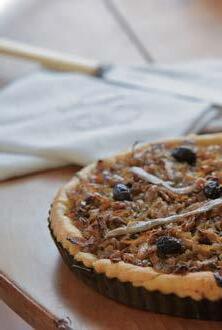
18 2023 - Press kit - Cuisine Nissarde Label
Chard Pie
Tourta de Blea
Ingredients for 8 people
PASTRY
> 500 g flour,
> 250 g butter,
> 150g granulated sugar,
> 100g icing sugar for decoration,
> 2 eggs,
> 1 pinch of salt,
> Water (if necessary).
FILLING
> 1,5 kg of thin-ribbed chard leaves (preferably white chard),
> 50 g grated dry cow’s mountain cheese (sbrinz cheese),
> 2 eggs,
> 2 to 3 russet apples,
> 100 g pine kernels,
> 30 g brown raisins & 30 g white raisins (soaked in rum 150ml),
> 1 glass of brandy (5cl),
> 150 g granulated or brown sugar,
> 1 tablespoon olive oil,
> 1 tablespoon aniseed,
Preparation time: 40 minutes
Cooking time: 40 minutes
Season: throughout the year
Variations : add 50 grams of almond powder in the filling
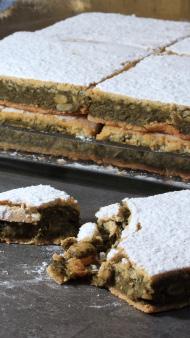
To prepare the pastry: in a bowl, mix the flour, sugar and salt and then, in the centre, the diced butter, eggs and olive oil. Mix using the fingertips for a few minutes to obtain a smooth and homogeneous paste (adding a few drops of water if necessary), place it in a cool place covered with a cloth. Let it rest during the preparation of the filling.
To prepare the filling: for this tourte, use only the green part of the Swiss chard. Make 3 cm diameter rolls with the sheets and cut them into fine strips the width of a finger. Plunge the chard into a basin of cold water and wash it three times. This removes the bitterness from the chard. Spin the strips and dry them between two dishtowels.
In a bowl, mix the eggs well to omelette consistency with the brown sugar, the brandy, the drained raisins in rum, olive oil, cheese and the pine nuts. Mix with your whole hands. Add the chard and a peeled diced apple.
Flatten two-thirds of the pastry out to 3 to 4 mm thick with a rolling pin on a worktop generously covered with flour, making a round which will be placed in the pie dish, allowing it to overflow. Insert the filling to a thickness of a good two centimetres. Add the juice from the bottom of the bowl, then spread the apple strips one beside the other. Spread the last third of the pastry to the diameter of the dish and, after wetting the edges, place it on the filling by carefully closing the two edges to seal them well. Using a fork, make small chimneys on the surface or make birds beaks with small scissors.
Put the pie in the oven at 180°C for 40 minutes: the surface must take on a golden colour... (When the edges recede from the dish, the tourte is cooked). Remove the tourte from the oven and sprinkle it with granulated sugar. When it is cool, sprinkle it with icing sugar to decorate, before serving it at room temperature.
19 2023 - Press kit - Cuisine Nissarde Label
Nice Côte d’Azur Convention & Visitors Bureau




B.P. 4079 - 06302 NICE CEDEX 4 info@nicecotedazurtourisme.com Retrouvez-nous sur ExploreNiceCotedAzur ExploreNCA ExploreNiceCotedAzur nice-convention-&-visitors-bureau explorenicecotedazur


June 2023Nice Côte d’Azur Convention & Visitors Bureau
NiceCotedAzurTourisme explorenicecotedazur.com




















































